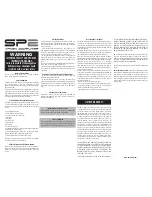
TIMING CONTROL
BASIC TIMING CONTROL
This instrument can be triggered by its own internal clock or by an external TTL trigger
signal. In either case, two output channels respond to the trigger: PULSE and SYNC.
The PULSE output is a bipolar signal that may either drive a 50 Ohm load, or the test jig
described later. The positive and negative amplitudes are adjustable. The pulse widths
are variable over a 2-20 us range.
The SYNC pulse is a fixed-width TTL-level reference pulse used to trigger
oscilloscopes or other measurement systems. When the delay is set to a positive value
the SYNC pulse precedes the PULSE output. When the delay is set to a negative value
the SYNC pulse follows the PULSE output.
These pulses are illustrated below, assuming internal triggering and a positive delay:
Figure A
If the delay is negative, the order of the SYNC and PULSE outputs is reversed:
21
SYNC OUT
(generated by the
internal oscillator)
100 ns, FIXED
Mainframe OUT
DELAY > 0
3V, FIXED
PW 1
PW 2
AMP1 (+),
VARIABLE
AMP2 (-),
VARIABLE
Содержание AVR-EB4-B
Страница 45: ...The next photo shows a MELF device installed between the two pins 45 A MELF packaged Device Under Test DUT...
Страница 57: ...Then open the tan colored DUT socket by flipping forward the two black latches on the front edge of it 57...
Страница 69: ...PCB 158R5 LOW VOLTAGE POWER SUPPLY...
Страница 71: ...PCB 104G KEYPAD DISPLAY BOARD...
Страница 76: ...TEST JIG WIRING AVX TRR HPOST...
Страница 83: ...PERFORMANCE CHECK SHEET 83...
















































